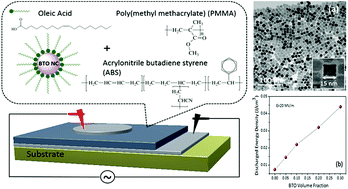Fabrication of barium titanate/acrylonitrile-butadiene styrene/poly(methyl methacrylate) nanocomposite films for hybrid ferroelectric capacitors
Abstract
A new organic–inorganic ferroelectric hybrid capacitor designed by uniformly incorporating surface modified monodisperse 15 nm ferroelectric BaTiO3 nanocubes into non-polar polymer blends of poly(methyl methacrylate) (PMMA) polymer and acrylonitrile-butadiene-styrene (ABS) terpolymer is described. The investigation of spatial distribution of nanofillers via a non-distractive thermal pulse method illustrates that the surface functionalization of nanocubes plays a key role in the uniform distribution of charge polarization within the polymer matrix. The discharged energy density of the nanocomposite with 30 vol% BaTiO3 nanocubes is ∼44 × 10−3 J cm−3, which is almost six times higher than that of the neat polymer. The facile processing, along with the superior mechanical and electrical properties of the BaTiO3/PMMA–ABS nanocomposites make them suitable for implementation into capacitive electrical energy storage devices.


 Please wait while we load your content...
Please wait while we load your content...